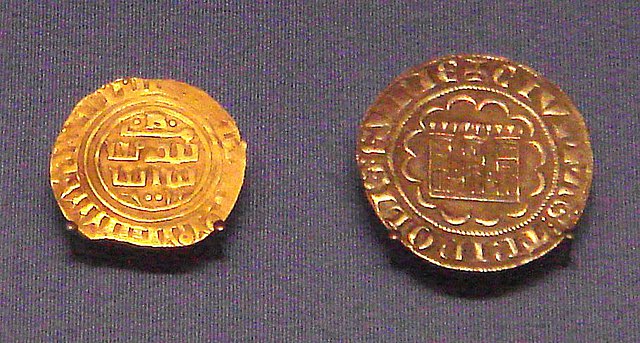In the Middle Ages, the term bezant was used in Western Europe to describe several gold coins of the east, all derived ultimately from the Roman solidus. The word itself comes from the Greek Byzantion, the ancient name of Constantinople, the capital of the Byzantine Empire.
Crusader coins of the Kingdom of Jerusalem: Denier in European style with Holy Sepulchre (1162–75); Kufic gold bezant (1140–1180); gold bezant with Christian symbol (1250s) (British Museum). Gold coins were first copied dinars and bore Kufic script, but after 1250 Christian symbols were added following Papal complaints.
County of Tripoli gold bezant in Arabic (1270–1300), and Tripoli silver gros (1275–1287). British Museum.
Arms of Sir John Russell, a 13th-century English courtier.
The solidus or nomisma was a highly pure gold coin issued in the Later Roman Empire and Byzantine Empire. The early 4th century saw the solidus introduced in mintage as a successor to the aureus, which was permanently replaced thereafter by the new coin, whose weight of about 4.5 grams remained relatively constant for seven centuries.
Solidus of Theodosius II, minted in Constantinople c. 435. This design of the emperor with the spear over his shoulder was the conventional portrait for over a century in the Eastern Roman Empire, from AD 395 to 537
Solidus of Constantine the Great, minted in AD 324 or 325
Solidus of Constantius II from Antioch, 347–355. A holed coin such as this was likely worn as a jewelry piece by a prominent or wealthy Roman
Light-weight solidus of 22 siliquae minted by emperor Tiberius Constantine at Antioch in Syria, c. 580. The light-weight solidi were minted from c. 550–650 and were primarily used for foreign trade with Europe.







